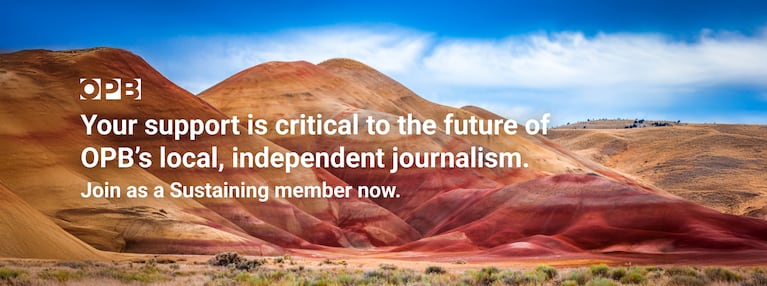Across Oregon, school districts that have long been underfunded are trying to decide how to spend an influx of money – about $1 billion a year – made possible by a new tax on businesses. That tax takes effect Jan. 1.
All the detailed rules of the tax aren’t done yet, nor are the schools’ plans.
As the clocks tick down, OPB spent time in one community – the Coast Range town of Philomath – to see how it’s preparing.
Related: Oregon's Business Tax Is Not Going To Voters — Here's What You Should Know
“I think it’s going to help us level the playing field so that the kids who are struggling now have the opportunities to be successful,” said Philomath Superintendent Buzz Brazeau.
With six schools and about 1,600 students, the Philomath School District isn’t Oregon’s largest or smallest district. According to state estimates, the district will receive $1 million from an account in the Student Success Act.
But there are still a lot of decisions to be made about how districts like Philomath will spend their money.
And businesses are trying to plan too. One family-run logging operation in Philomath, called Emerald Valley Thinning, is worried the state’s new tax will take too large a bite out of small profits.
“They’re putting it all on the backs of businesses, which ends up being the backs of workers,” said office manager Jessica Yandell. She’s a graduate of Philomath’s public schools and now has a child attending them.
New Funding, Cautious Optimism
At Philomath High, Dan Johnson points out the wooden accents around the school – wood beams line the ceiling and border the stairs.

Dan Johnson is in his 17th year at Philomath Schools. He's currently the high school's success coordinator and runs the district's alternative education program.
Elizabeth Miller / OPB
“We try to pay homage to our roots of industry, forestry with all the wood beams and the wood front,” Johnson said. “I think it’s important – know where you came from, but know that we’re going to move forward.”
That move forward includes $1 million to the district from the state’s Student Success Act.
The bill's passage was one of Gov. Kate Brown's biggest accomplishments in the last legislative session and represented a culmination of almost two years of work. In 2018, a group of legislators toured schools around the state to ask what they needed and created a wish list of spending priorities for the state. But it didn't pass the legislature easily. After a four-day standoff with Senate Republicans, a deal was made and the bill passed.
The new tax is considered a huge win for the state’s public schools, which have endured decades of difficulty, marked by some of the nation's shortest school years and lowest graduation rates.
School districts get the majority of the annual $1 billion. Early childhood education and statewide initiatives both receive funding through the bill as well. For school districts, the funds must be used to help underserved student groups (such as students of color, low-income children or students with disabilities) or to expand mental health resources.
Schools apply for noncompetitive grants in the spring, but before that, they have to figure out how best to spend the money – and make sure they engage the community in that process.
In Philomath, the district hosted a meeting in October for families and staff.
Parents, teachers, and staff had plenty of ideas. They talked about extending the school day, hiring more family-support liaisons, training staff to help students in crisis, and having more help in the classroom and counseling office.
Brazeau, the district's superintendent, said the money will go to Philomath students who need additional supports in the form of trauma-informed care and mental health counseling. He also thinks the money could help create flexibility for students with learning styles that don’t adhere to the typical school day.

Philomath Schools Superintendent Buzz Brazeau in his office on Oct. 30, 2019.
Elizabeth Miller / OPB
“I think we have to look at the models and the constraints and push those down … through some alternative-type programming,” Brazeau said.
Student input is welcome, too. Philomath junior Ashlie Stroebel said the money should go to new clubs at school and more counseling.
“Bullying prevention, or better clubs for counseling,” Stroebel said. “We have one-on-one counselors, but they relate to your school and academic work.”
For Johnson, the funding means a possible expansion of the school’s career technical education program.
One-third of Philomath High students participate in the school’s forestry program. But there are also students involved in culinary arts, manufacturing technology and web design. The district may soon add a business program, or extend career education into middle school.
But for all the opportunity this new money brings, Johnson feels pressure, too.
“I have concerns that because it sounds like it’s a huge amount of money, people are going to expect a lot,” Johnson said.
He also wants to make sure the district spends its funds wisely.
A Dance of Profitability
Drive about 10 miles down the road from the high school, swing a left at the #TimberUnity sign, and you’ll reach the office of a family-run logging operation called Emerald Valley Thinning.
The walls are adorned with plaques marking owner Tracy Smouse’s wins at various timber sports competitions. His team’s fastest time splicing cable at a logging championship?
“Two minutes.”

Tracy Smouse of Philomath, Ore., has been a logger for decades. He said the changing business climate of the state can feel overwhelming.
Kate Davidson/OPB
The new tax to fund education feels less like a win for Smouse. In fact, he’s worried it will hurt his business and employees.
The Corporate Activity Tax (CAT) is often referred to as a gross receipts tax. It's a tax based on revenue, not profit.
Jessica Yandell is the office manager at Emerald Valley Thinning. She's been doing a lot of math lately, trying to get a ballpark figure for how much the tax will cost them. And she gets the basic formula: It's a .57% tax on Oregon revenue that's above $1 million after a fraction of their costs are deducted. As with most taxes, there are some exemptions.
Yandell is worried. The company brings in well over $1 million in “commercial activity” each year, but its profit margins are slim.
“Gross revenue last year was approximately $5.5 million. But our expense was approximately $5.5 million,” she said. Any extra money usually goes back into operations, since repairing a piece of heavy machinery can cost thousands of dollars.
It’s a dance of profitability.
“There are some years where we make a little bit. There are some years where we lose a little bit,” she said. “I’m concerned about those years where we don’t make anything.” But they still have to pay the tax.
Related: Opponents Scrap Campaign To Refer New $1B Business Tax To Oregon Voters
The effect of the commercial activities tax on high-volume, low-margin operations was one of many concerns businesses raised in the run-up to its passage. Legislators made some concessions. The tax ultimately passed with the support of prominent companies like Nike and the stated neutrality of the powerful group Oregon Business & Industry. The law creating it also reduced the personal income tax rate for the lowest three tax brackets.
In Philomath, Smouse wants to plan for the new tax, but he’s still not sure how much it will cost him. That’s partly because some of the tax’s mechanics are still being hammered out in an administrative rulemaking process.
“They’re not done writing it,” he said. “So we don’t know. There’s too many unknowns.”
In the meantime, he and his office manager are wondering where they can cut corners. They don’t think they can pass the cost to their customers, because they bid for jobs on private land.
“We could try to,” Smouse said. “But we might price ourself out of a job by doing so.”
They don’t want to cut wages. They want to stay well above the state’s rising minimum wage because it’s hard finding people to work in the woods.

Jessica Yandell and Tracy Smouse outside the office of Emerald Valley Thinning in Philomath, Ore., on Nov. 7, 2019. The structure of the new business tax concerns them since it applies to revenue, not profit.
Kate Davidson / OPB
“Quite honestly, it’s dirty work and it’s long days,” he said.
They’ve also discussed contributing less to employees’ medical insurance or cutting back on overtime. That would affect Yandell’s family budget as well since her husband is also a logger with the company.
“We do not have the finest of anything,” she said. “Our main priority is providing for our kids and making sure that they have a roof over their heads and food in their tummies.”
Across Oregon, there are companies too small to be liable for the new tax. Others will pass the cost forward. There are big companies, like Nike, that make most of their money outside the state, where it’s not subject to the tax. And there are companies like Emerald Valley Thinning.
Yandell attended Philomath High, with its big wooden beams and wooden face. She and her husband were high school sweethearts there. They have a child in public school. Along with Smouse, they still judge the high school's student forestry competitions. Still, Yandell feels the state wasn’t seeing companies like hers when it chose a gross receipts tax to fund the schools.

Banners and posters show school pride all over Philomath High.
Elizabeth Miller / OPB
As businesses prepare for the new tax, school districts are preparing their applications to the state for Student Success Act funds.
“We want to target the money so that students can be — and are — successful,” Dan Johnson said.
Over the years, funds produced by the tax will likely increase, sending more money to schools around Oregon. The hope is that the state investment will pay off in the long run for students and their communities. The hope for businesses is that the cost of helping schools won’t mean an economic hit they can’t handle.


